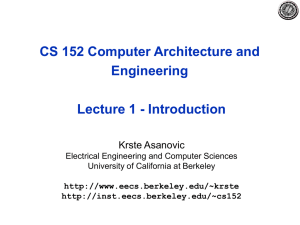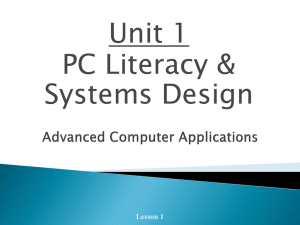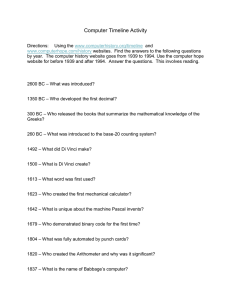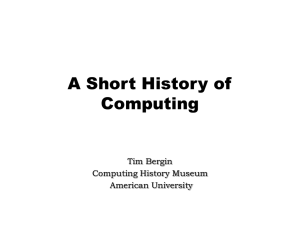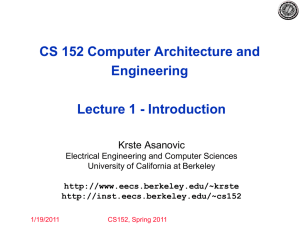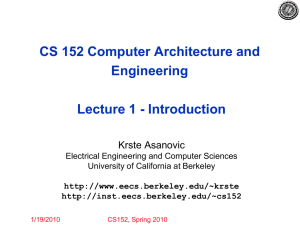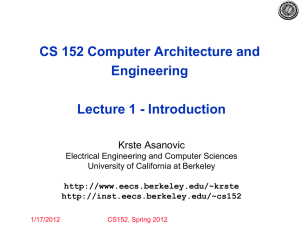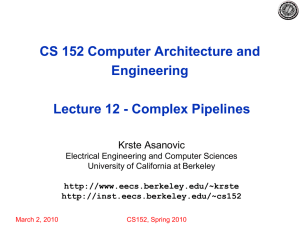CS 152 Computer Architecture and Engineering Lecture 1 - Introduction Krste Asanovic
advertisement
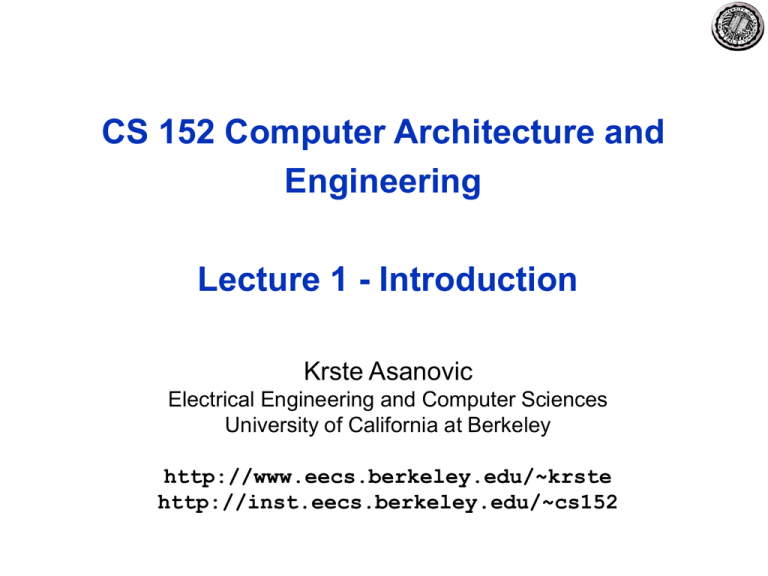
CS 152 Computer Architecture and Engineering Lecture 1 - Introduction Krste Asanovic Electrical Engineering and Computer Sciences University of California at Berkeley http://www.eecs.berkeley.edu/~krste http://inst.eecs.berkeley.edu/~cs152 Computing Devices Then… EDSAC, University of Cambridge, UK, 1949 1/22/2008 CS152-Spring’08 2 Computing Devices Now Sensor Nets QuickT ime ™an d a TIFF ( Uncomp res sed) deco mpre ssor ar e need ed to see this pictur e. Cameras Set-top boxes Games QuickTime™ and a TIFF (Uncompressed) decompressor are needed to see this picture. QuickTime™ and a TIFF (Uncompress ed) dec ompres sor are needed t o s ee this pic ture. Media Players QuickTime™ and a TIFF (Uncompressed) decompressor are needed to see this picture. Laptops Servers Routers Smart phones Automobiles 1/22/2008 CS152-Spring’08 Robots Supercomputers 3 What is Computer Architecture? Application Gap too large to bridge in one step (but there are exceptions, e.g. magnetic compass) Physics In its broadest definition, computer architecture is the design of the abstraction layers that allow us to implement information processing applications efficiently using available manufacturing technologies. 1/22/2008 CS152-Spring’08 4 Abstraction Layers in Modern Systems Application Algorithm Programming Language Original domain of the computer architect (‘50s-’80s) Operating System/Virtual Machines Instruction Set Architecture (ISA) Microarchitecture Gates/Register-Transfer Level (RTL) Domain of recent computer architecture (‘90s) Circuits Devices Physics 1/22/2008 CS152-Spring’08 5 Uniprocessor Performance 10000 Performance (vs. VAX-11/780) From Hennessy and Patterson, Computer Architecture: A Quantitative Approach, 4th edition, October, 2006 ??%/year 1000 52%/year 100 10 25%/year 1 1978 1980 1982 1984 1986 1988 1990 1992 1994 1996 1998 2000 2002 2004 2006 • VAX : 25%/year 1978 to 1986 • RISC + x86: 52%/year 1986 to 2002 • RISC + x86: ??%/year 2002 to present 1/22/2008 CS152-Spring’08 6 The End of the Uniprocessor Era Single biggest change in the history of computing systems 1/22/2008 CS152-Spring’08 7 Conventional Wisdom in Computer Architecture • Old Conventional Wisdom: Power is free, Transistors expensive • New Conventional Wisdom: “Power wall” Power expensive, Transistors free (Can put more on chip than can afford to turn on) • Old CW: Sufficient increasing Instruction-Level Parallelism via compilers, innovation (pipelining, superscalar, out-of-order, speculation, VLIW, …) • New CW: “ILP wall” law of diminishing returns on more HW for ILP • Old CW: Multiplies are slow, Memory access is fast • New CW: “Memory wall” Memory slow, multiplies fast (200 clock cycles to DRAM memory, 4 clocks for multiply) • Old CW: Uniprocessor performance 2X / 1.5 yrs • New CW: Power Wall + ILP Wall + Memory Wall = Brick Wall – Uniprocessor performance now 2X / 5(?) yrs Sea change in chip design: multiple “cores” (2X processors per chip / ~ 2 years) » More, simpler processors are more power efficient 1/22/2008 CS152-Spring’08 8 Sea Change in Chip Design • Intel 4004 (1971): 4-bit processor, 2312 transistors, 0.4 MHz, 10 micron PMOS, 11 mm2 chip • RISC II (1983): 32-bit, 5 stage pipeline, 40,760 transistors, 3 MHz, 3 micron NMOS, 60 mm2 chip • 125 mm2 chip, 0.065 micron CMOS = 2312 RISC II+FPU+Icache+Dcache – RISC II shrinks to ~ 0.02 mm2 at 65 nm – Caches via DRAM or 1 transistor SRAM? • Processor is the new transistor? 1/22/2008 CS152-Spring’08 9 Déjà vu all over again? • Multiprocessors imminent in 1970s, ‘80s, ‘90s, … • “… today’s processors … are nearing an impasse as technologies approach the speed of light..” David Mitchell, The Transputer: The Time Is Now (1989) • Transputer was premature Custom multiprocessors tried to beat uniprocessors Procrastination rewarded: 2X seq. perf. / 1.5 years • “We are dedicating all of our future product development to multicore designs. … This is a sea change in computing” Paul Otellini, President, Intel (2004) • Difference is all microprocessor companies have switched to multiprocessors (AMD, Intel, IBM, Sun; all new Apples 2+ CPUs) Procrastination penalized: 2X sequential perf. / 5 yrs Biggest programming challenge: from 1 to 2 CPUs 1/22/2008 CS152-Spring’08 10 Problems with Sea Change • Algorithms, Programming Languages, Compilers, Operating Systems, Architectures, Libraries, … not ready to supply Thread-Level Parallelism or Data-Level Parallelism for 1000 CPUs / chip, • Architectures not ready for 1000 CPUs / chip – Unlike Instruction-Level Parallelism, cannot be solved by computer architects and compiler writers alone, but also cannot be solved without participation of architects • Need a reworking of all the abstraction layers in the computing system stack 1/22/2008 CS152-Spring’08 11 Abstraction Layers in Modern Systems Application Algorithm Parallel computing, security, … Programming Language Original domain of the computer architect (‘50s-’80s) Operating System/Virtual Machines Instruction Set Architecture (ISA) Microarchitecture Gates/Register-Transfer Level (RTL) Circuits Devices Domain of recent computer architecture (‘90s) Reliability, power, … Physics Reinvigoration of computer architecture, mid-2000s onward. 1/22/2008 CS152-Spring’08 12 The New CS152 • New CS152 focuses on interaction of software and hardware – more architecture and less digital engineering. • No FPGA design component – We are preparing a separate FPGA design lab class for Fall 2008, where you can try building some of the architectural ideas we’ll explore this semester (100% digital engineering) • Much of the material you’ll learn this term was previously in CS252 – Some of the current CS61C, I first saw in CS252 nearly 20 years ago! – Maybe every 10 years, shift CS252->CS152->CS61C? • Class contains labs based on various different machine designs – Experiment with how architectural mechanisms work in practice on real software. 1/22/2008 CS152-Spring’08 13 CS 152 Course Focus Understanding the design techniques, machine structures, technology factors, evaluation methods that will determine the form of computers in 21st Century Technology Applications Programming Languages Computer Architecture: • Organization • Hardware/Software Boundary Operating Systems 1/22/2008 Parallelism Measurement & Evaluation CS152-Spring’08 Interface Design (ISA) Compilers History 14 The New CS152 Executive Summary The processor your predecessors built in CS152 What you’ll understand and experiment with in the new CS152 Plus, the technology behind chip-scale multiprocessors (CMPs) 1/22/2008 CS152-Spring’08 15 CS152 Administrivia Instructor: Prof. Krste Asanovic Office: 645 Soda Hall, krste@eecs Office Hours: M 1-3PM (email to confirm), 645 Soda Hall T. A.: Henry Cook, hcook@eecs Office Hours: TBD Lectures: Tu/Th, 2:00-3:30PM, 320 Soda Section: W 10:00-11:00AM, 2 Evans Text: Computer Architecture: A Quantitative Approach, 4th Edition (Oct, 2006) Readings assigned from this edition, don’t use earlier Eds. Web page: http://inst.eecs.berkeley.edu/~cs152 Lectures available online before noon, day of lecture 1/22/2008 CS152-Spring’08 16 CS152 Structure and Syllabus • Approximately 7 modules – Simple machine design (ISAs, microprogramming, unpipelined machines, Iron Law) – Simple pipelining (hazards, 2,5,7+ stage pipelines, branch prediction, in-order superscalar, Little’s Law, optimizations) – Memory systems (DRAM, caches, optimizations) – Virtual memory systems, exceptions, interrupts – Complex pipelining (score-boarding, out-of-order issue) – Explicitly parallel processors (vector machines, VLIW machines, multithreaded machines) – Multiprocessor designs (cache coherence, memory models, synchronization) 1/22/2008 CS152-Spring’08 17 CS152 Course Components • 20% Problem Sets (one per module) – Intended to help you learn the material. Feel free to discuss with other students and instructors, but must turn in your own solutions. Grading based mostly on effort, but quizzes assume that you have worked through all problems. Solutions released after PSs handed in. • 40% Quizzes (one per module) – In-class, closed-book, no calculators or computers. – Based on lectures, problem sets, and labs • 40% Labs (one per module) – This term mostly labs are mostly using advanced simulators (Virtutech Simics), possibly some real machines too – Directed plus open-ended sections to each lab 1/22/2008 CS152-Spring’08 18 CS152 Labs • Each lab has directed plus open-ended assignments – Roughly 50/50 split of grade • Directed portion is intended to ensure students learn main concepts behind lab – Each student must perform own lab and hand in their own lab report • Open-ended assigment is to allow you to show your creativity – Roughly a one day “mini-project” » E.g., try an architectural idea and measure potential, negative results OK (if explainable!) – Students can work individually or in groups of two or three – Group open-ended lab reports must be handed in separately – Students can work in different groups for different assignments 1/22/2008 CS152-Spring’08 19 Related Courses CS 258 Parallel Architectures, Languages, Systems CS61C Strong Prerequisite Basic computer organization, first look at pipelines + caches 1/22/2008 CS 152 Computer Architecture, First look at parallel architectures CS 252 Graduate Computer Architecture, Advanced Topics CS 150 CS 194?? Digital Logic Design New FPGA-based Architecture Lab Class CS152-Spring’08 20 Computer Architecture: A Little History Throughout the course we’ll use a historical narrative to help understand why certain ideas arose Why worry about old ideas? • Helps to illustrate the design process, and explains why certain decisions were taken • Because future technologies might be as constrained as older ones • Those who ignore history are doomed to repeat it – Every mistake made in mainframe design was also made in minicomputers, then microcomputers, where next? 1/22/2008 CS152-Spring’08 21 Charles Babbage 1791-1871 Lucasian Professor of Mathematics, Cambridge University, 1827-1839 1/22/2008 CS152-Spring’08 22 Charles Babbage • Difference Engine 1823 • Analytic Engine 1833 – The forerunner of modern digital computer! Application – Mathematical Tables – Astronomy – Nautical Tables – Navy Background – Any continuous function can be approximated by a polynomial --Weierstrass Technology – mechanical - gears, Jacquard’s loom, simple calculators 1/22/2008 CS152-Spring’08 23 Difference Engine A machine to compute mathematical tables Weierstrass: – Any continuous function can be approximated by a polynomial – Any polynomial can be computed from difference tables An example f(n) d1(n) d2(n) = n2 + n + 41 = f(n) - f(n-1) = 2n = d1(n) - d1(n-1) = 2 f(n) = f(n-1) + d1(n) = f(n-1) + (d1(n-1) + 2) all you need is an adder! n 0 1 2 3 4 2 2 2 2 4 6 8 43 47 53 61 d2(n) d1(n) f(n) 1/22/2008 41 CS152-Spring’08 24 Difference Engine 1823 – Babbage’s paper is published 1834 – The paper is read by Scheutz & his son in Sweden 1842 – Babbage gives up the idea of building it; he is onto Analytic Engine! 1855 – Scheutz displays his machine at the Paris World Fare – Can compute any 6th degree polynomial – Speed: 33 to 44 32-digit numbers per minute! Now the machine is at the Smithsonian 1/22/2008 CS152-Spring’08 25 Analytic Engine 1833: Babbage’s paper was published – conceived during a hiatus in the development of the difference engine Inspiration: Jacquard Looms – looms were controlled by punched cards » The set of cards with fixed punched holes dictated the pattern of weave program » The same set of cards could be used with different colored threads numbers 1871: Babbage dies – The machine remains unrealized. It is not clear if the analytic engine could be built even today using only mechanical technology 1/22/2008 CS152-Spring’08 26 Analytic Engine The first conception of a general-purpose computer 1. The store in which all variables to be operated upon, as well as all those quantities which have arisen from the results of the operations are placed. 2. The mill into which the quantities about to be operated upon are always brought. The program Operation variable1 variable2 variable3 An operation in the mill required feeding two punched cards and producing a new punched card for the store. An operation to alter the sequence was also provided! 1/22/2008 CS152-Spring’08 27 The first programmer Ada Byron aka “Lady Lovelace” 1815-52 Ada’s tutor was Babbage himself! 1/22/2008 CS152-Spring’08 28 Babbage’s Influence • Babbage’s ideas had great influence later primarily because of – Luigi Menabrea, who published notes of Babbage’s lectures in Italy – Lady Lovelace, who translated Menabrea’s notes in English and thoroughly expanded them. “... Analytic Engine weaves algebraic patterns....” • In the early twentieth century - the focus shifted to analog computers but – Harvard Mark I built in 1944 is very close in spirit to the Analytic Engine. 1/22/2008 CS152-Spring’08 29 Harvard Mark I • Built in 1944 in IBM Endicott laboratories – Howard Aiken – Professor of Physics at Harvard – Essentially mechanical but had some electro-magnetically controlled relays and gears – Weighed 5 tons and had 750,000 components – A synchronizing clock that beat every 0.015 seconds (66Hz) Performance: 0.3 seconds for addition 6 seconds for multiplication 1 minute for a sine calculation Broke down once a week! 1/22/2008 CS152-Spring’08 30 Linear Equation Solver John Atanasoff, Iowa State University 1930’s: – Atanasoff built the Linear Equation Solver. – It had 300 tubes! Application: – Linear and Integral differential equations Background: – Vannevar Bush’s Differential Analyzer --- an analog computer Technology: – Tubes and Electromechanical relays Atanasoff decided that the correct mode of computation was by electronic digital means. 1/22/2008 CS152-Spring’08 31 Electronic Numerical Integrator and Computer (ENIAC) • Inspired by Atanasoff and Berry, Eckert and Mauchly designed and built ENIAC (1943-45) at the University of Pennsylvania • The first, completely electronic, operational, general-purpose analytical calculator! – 30 tons, 72 square meters, 200KW • Performance – Read in 120 cards per minute – Addition took 200 ms, Division 6 ms – 1000 times faster than Mark I WW-2 Effort • Not very reliable! Application: Ballistic calculations angle = f (location, tail wind, cross wind, air density, temperature, weight of shell, propellant charge, ... ) 1/22/2008 CS152-Spring’08 32 Electronic Discrete Variable Automatic Computer (EDVAC) • ENIAC’s programming system was external – Sequences of instructions were executed independently of the results of the calculation – Human intervention required to take instructions “out of order” • Eckert, Mauchly, John von Neumann and others designed EDVAC (1944) to solve this problem – Solution was the stored program computer “program can be manipulated as data” • First Draft of a report on EDVAC was published in 1945, but just had von Neumann’s signature! – In 1973 the court of Minneapolis attributed the honor of inventing the computer to John Atanasoff 1/22/2008 CS152-Spring’08 33 Stored Program Computer Program = A sequence of instructions How to control instruction sequencing? manual control calculators automatic control external (paper tape) Harvard Mark I , 1944 Zuse’s Z1, WW2 internal plug board read-only memory read-write memory ENIAC ENIAC EDVAC 1946 1948 1947 (concept ) • The same storage can be used to store program and data EDSAC 1/22/2008 1950 CS152-Spring’08 Maurice Wilkes 34 Technology Issues ENIAC 18,000 tubes 20 10-digit numbers EDVAC 4,000 tubes 2000 word storage mercury delay lines ENIAC had many asynchronous parallel units but only one was active at a time BINAC : Two processors that checked each other for reliability. Didn’t work well because processors never agreed 1/22/2008 CS152-Spring’08 35 Dominant Problem: Reliability Mean time between failures (MTBF) MIT’s Whirlwind with an MTBF of 20 min. was perhaps the most reliable machine ! Reasons for unreliability: 1. Vacuum Tubes 2. Storage medium acoustic delay lines mercury delay lines Williams tubes Selections Reliability solved by invention of Core memory by J. Forrester 1954 at MIT for Whirlwind project 1/22/2008 CS152-Spring’08 36 Commercial Activity: 1948-52 IBM’s SSEC Selective Sequence Electronic Calculator – 150 word store. – Instructions, constraints, and tables of data were read from paper tapes. – 66 Tape reading stations! – Tapes could be glued together to form a loop! – Data could be output in one phase of computation and read in the next phase of computation. 1/22/2008 CS152-Spring’08 37 And then there was IBM 701 IBM 701 -- 30 machines were sold in 1953-54 IBM 650 -- a cheaper, drum based machine, more than 120 were sold in 1954 and there were orders for 750 more! Users stopped building their own machines. Why was IBM late getting into computer technology? IBM was making too much money! Even without computers, IBM revenues were doubling every 4 to 5 years in 40’s and 50’s. 1/22/2008 CS152-Spring’08 38 Computers in mid 50’s • Hardware was expensive • Stores were small (1000 words) No resident system-software! • Memory access time was 10 to 50 times slower than the processor cycle Instruction execution time was totally dominated by the memory reference time. • The ability to design complex control circuits to execute an instruction was the central design concern as opposed to the speed of decoding or an ALU operation • Programmer’s view of the machine was inseparable from the actual hardware implementation 1/22/2008 CS152-Spring’08 39 The IBM 650 (1953-4) Magnetic Drum (1,000 or 2,000 10-digit decimal words) Active instruction (including next program counter) Digit-serial ALU 20-digit accumulator 1/22/2008 [From 650 Manual, © IBM] CS152-Spring’08 40 Programmer’s view of the IBM 650 A drum machine with 44 instructions Instruction: 60 1234 1009 • “Load the contents of location 1234 into the distribution; put it also into the upper accumulator; set lower accumulator to zero; and then go to location 1009 for the next instruction.” Good programmers optimized the placement of instructions on the drum to reduce latency! 1/22/2008 CS152-Spring’08 41 The Earliest Instruction Sets Single Accumulator - A carry-over from the calculators. LOAD STORE x x AC M[x] M[x] (AC) ADD SUB x x AC (AC) + M[x] MUL DIV x x Involved a quotient register SHIFT LEFT SHIFT RIGHT AC 2 (AC) JUMP JGE x x PC x if (AC) 0 then PC x LOAD ADR STORE ADR x x AC Extract address field(M[x]) Typically less than 2 dozen instructions! 1/22/2008 CS152-Spring’08 42 Programming: Single Accumulator Machine Ci Ai + Bi, 1 i n LOOP F1 F2 F3 DONE LOAD JGE ADD STORE LOAD ADD STORE JUMP HLT N DONE ONE N A B C LOOP A B C N ONE -n 1 code How to modify the addresses A, B and C ? 1/22/2008 CS152-Spring’08 43 Self-Modifying Code LOOP LOAD JGE ADD STORE F1 LOAD F2 ADD F3 STORE JUMP ADR LOAD DONE ADD HLT STORE ADR modify the LOAD ADR program ADD for the next STORE ADR iteration LOAD ADR ADD STORE ADR JUMP DONE HLT 1/22/2008 N DONE ONE N A B C LOOP F1 ONE F1 F2 ONE F2 F3 ONE F3 LOOP Ci Ai + Bi, 1 i n CS152-Spring’08 Each iteration involves total bookkeeping instruction 14 fetches 17 operand fetches stores 10 8 5 4 44 Index Registers Tom Kilburn, Manchester University, mid 50’s One or more specialized registers to simplify address calculation Modify existing instructions LOAD ADD ... x, IX x, IX AC M[x + (IX)] AC (AC) + M[x + (IX)] Add new instructions to manipulate index registers JZi x, IX LOADi ... x, IX if (IX)=0 then PC x else IX (IX) + 1 IX M[x] (truncated to fit IX) Index registers have accumulator-like characteristics 1/22/2008 CS152-Spring’08 45 Using Index Registers Ci Ai + Bi, 1 i n LOOP DONE LOADi JZi LOAD ADD STORE JUMP HALT -n, IX DONE, IX LASTA, IX LASTB, IX LASTC, IX LOOP A LASTA • Program does not modify itself • Efficiency has improved dramatically (ops / iter) instruction fetch operand fetch store • Costs: 1/22/2008 with index regs without index regs 17 (14) 5(2) 10 (8) 2 5 (4) 1 Instructions are 1 to 2 bits longer Index registers with ALU-like circuitry Complex control CS152-Spring’08 46 Operations on Index Registers To increment index register by k AC (IX) AC (AC) + k IX (AC) new instruction new instruction also the AC must be saved and restored. It may be better to increment IX directly INCi k, IX IX (IX) + k More instructions to manipulate index register STOREi ... x, IX M[x] (IX) (extended to fit a word) IX begins to look like an accumulator several index registers several accumulators General Purpose Registers 1/22/2008 CS152-Spring’08 47 Evolution of Addressing Modes 1. Single accumulator, absolute address LOAD x 2. Single accumulator, index registers LOAD x, IX LOAD (x) 3. Indirection 4. Multiple accumulators, index registers, indirection or LOAD LOAD R, IX, x R, IX, (x) the meaning? R M[M[x] + (IX)] or R M[M[x + (IX)]] 5. Indirect through registers LOAD RI, (RJ) LOAD RI, RJ, (RK) 6. The works 1/22/2008 CS152-Spring’08 RJ = index, RK = base addr 48 Variety of Instruction Formats • Two address formats: the destination is same as one of the operand sources (Reg Reg) to Reg (Reg Mem) to Reg RI (RI) + (RJ) RI (RI) + M[x] – x can be specified directly or via a register – effective address calculation for x could include indexing, indirection, ... • Three address formats: One destination and up to two operand sources per instruction RI (RJ) + (RK) RI (RJ) + M[x] (Reg x Reg) to Reg (Reg x Mem) to Reg 1/22/2008 CS152-Spring’08 49 More Instruction Formats • Zero address formats: operands on a stack add load M[sp-1] M[sp] + M[sp-1] M[sp] M[M[sp]] Register SP A B C – Stack can be in registers or in memory (usually top of stack cached in registers) • One address formats: Accumulator machines – Accumulator is always other implicit operand Many different formats are possible! 1/22/2008 CS152-Spring’08 50 Data Formats and Memory Addresses Data formats: Bytes, Half words, words and double words Some issues • Byte addressing Most Significant Byte Big Endian vs. Little Endian 0 3 Least Significant Byte 1 2 2 1 3 0 Byte Addresses • Word alignment Suppose the memory is organized in 32-bit words. Can a word address begin only at 0, 4, 8, .... ? 0 1/22/2008 1 2 3 4 CS152-Spring’08 5 6 7 51 Software Developments up to 1955 Libraries of numerical routines - Floating point operations - Transcendental functions - Matrix manipulation, equation solvers, . . . 1955-60 High level Languages - Fortran 1956 Operating Systems - Assemblers, Loaders, Linkers, Compilers - Accounting programs to keep track of usage and charges Machines required experienced operators Most users could not be expected to understand these programs, much less write them 1/22/2008 Machines had to be sold with a lot of resident software CS152-Spring’08 52 Compatibility Problem at IBM By early 60’s, IBM had 4 incompatible lines of computers! 701 650 702 1401 7094 7074 7080 7010 Each system had its own • Instruction set • I/O system and Secondary Storage: magnetic tapes, drums and disks • assemblers, compilers, libraries,... • market niche business, scientific, real time, ... IBM 360 1/22/2008 CS152-Spring’08 53 IBM 360 : Design Premises Amdahl, Blaauw and Brooks, 1964 • The design must lend itself to growth and successor machines • General method for connecting I/O devices • Total performance - answers per month rather than bits per microsecond programming aids • Machine must be capable of supervising itself without manual intervention • Built-in hardware fault checking and locating aids to reduce down time • Simple to assemble systems with redundant I/O devices, memories etc. for fault tolerance • Some problems required floating point words larger than 36 bits 1/22/2008 CS152-Spring’08 54 IBM 360: A General-Purpose Register (GPR) Machine • Processor State – 16 General-Purpose 32-bit Registers » may be used as index and base register » Register 0 has some special properties – 4 Floating Point 64-bit Registers – A Program Status Word (PSW) » PC, Condition codes, Control flags • A 32-bit machine with 24-bit addresses – But no instruction contains a 24-bit address! • Data Formats – 8-bit bytes, 16-bit half-words, 32-bit words, 64-bit double-words The IBM 360 is why bytes are 8-bits long today! 1/22/2008 CS152-Spring’08 55 IBM 360: Initial Implementations Model 30 ... Storage 8K - 64 KB Datapath 8-bit Circuit Delay 30 nsec/level Local Store Main Store Control Store Read only 1msec Model 70 256K - 512 KB 64-bit 5 nsec/level Transistor Registers Conventional circuits IBM 360 instruction set architecture (ISA) completely hid the underlying technological differences between various models. Milestone: The first true ISA designed as portable hardware-software interface! With minor modifications it still survives today! 1/22/2008 CS152-Spring’08 56 IBM 360: Forty years later… The zSeries z990 Microprocessor • 64-bit virtual addressing – original S/360 was 24-bit, and S/370 was 31-bit extension • • • • • Dual core design Dual-issue in-order superscalar 10-stage CISC pipeline Out-of-order memory accesses Redundant datapaths – every instruction performed in two parallel datapaths and results compared • 256KB L1 I-cache, 256KB L1 D-cache on-chip • 32MB shared L2 unified cache, off-chip • 512-entry L1 TLB + 4K-entry L2 TLB – very large TLB, to support multiple virtual machines • 8K-entry Branch Target Buffer – Very large buffer to support commercial workloads • Up to 64 processors (48 visible to customer) in one machine • 1.2 GHz in IBM 130nm SOI CMOS technology, 55W for both cores [ IBM Journal R&D, 48(3/4), May/July 2004 ] 1/22/2008 CS152-Spring’08 57 And in conclusion … • Computer Architecture >> ISAs and RTL • CS152 is about interaction of hardware and software, and design of appropriate abstraction layers • Computer architecture is shaped by technology and applications – History provides lessons for the future • Computer Science at the crossroads from sequential to parallel computing – Salvation requires innovation in many fields, including computer architecture • Read Chapter 1, then Appendix B for next time! 1/22/2008 CS152-Spring’08 58 Acknowledgements • These slides contain material developed and copyright by: – – – – – – Arvind (MIT) Krste Asanovic (MIT/UCB) Joel Emer (Intel/MIT) James Hoe (CMU) John Kubiatowicz (UCB) David Patterson (UCB) • MIT material derived from course 6.823 • UCB material derived from course CS252 1/22/2008 CS152-Spring’08 59
